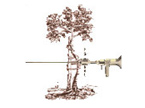Calcium deposits around the shoulder are a fairly common occurrence. Frequently they do not cause problems, but if they increase in size or become inflamed, then very severe pain may result. This collection of questions and answers is intended to explain this common shoulder problem and describe the methods we recommend for treatment in different situations.
What is the cause of calcium deposits around the shoulder?
In most situtations, there is no known cause for calcium deposits. Many people ask if their diet should be changed to reduce calcium intake. This should never be used as a form of treatment, since a normal balanced diet with a calcium supplement up to 1000mg a day is healthy in a normal patient, particularly senior citizens and post-menopausal females.
Who most commonly gets calcium deposits?
Calcium deposits occur most frequently in females between 35 and 65 years of age, but may occur in males as well.
Do all calcium deposits cause problems?
Many calcium deposits are present for years without causing any symptoms. Only when the deposit becomes large enough to pinch between the bones when the shoulder is elevated, does it cause pain. Sometimes smaller deposits cause pain if they become acutely inflamed, especially when the calcium salts leak from the lesion into the sensitive bursal tissues.
Does a calcium deposit damage my shoulder?
Some calcium deposits can cause erosion with the destruction of a portion of the rotator cuff tendon. Most calcium deposits remain on the outside of the rotator cuff tendon in the bursa and only cause problems because of their pain and catching.
Is the calcium deposit hard like a rock?
Most early calcium deposits are very soft like toothpaste, but sometimes after being present for a long period of time, they do dry up and become chalk-like, sometimes even turning to bone.
What is the best treatment for a calcium deposit?
When a calcium deposit becomes acutely inflamed, either because it ruptures and leaks calcium salts into the bursa, or because it pinches the bursa or rotator cuff, the symptoms can be quite severe. The acute inflammation can be treated with localized ice packs and rest in a sling, but oral anti-inflammatory medications are also helpful. A cortisone injection directly into the area of the calcium deposit may give relief within a few hours, when without it the acute severe pain may last for several days.
Do calcium deposits need removal?
If a patient has two or three recurrent episodes of painful symptoms in the shoulder, or if the calcium deposit appears on x-ray to be enlarging, then it may be appropriate to consider arthroscopic surgery to remove it.
What is involved in arthroscopic surgery to remove calcium?
The surgery is done in the outpatient department under a general anesthesia. There is no pain at all during the operation and afterwards a mild aching sensation is usually present for a few days until the skin puncture sites heal. If the calcium erodes a hole in the rotator cuff, then a decompression is necessary (removing a portion of the overhanging bone arthroscopically) and this will cause a little more discomfort for a few days.
Will calcification return once it is removed?
I have never seen a calcification return in the same shoulder once it has been removed.
Can there be any permanent damage caused by calcification?
Yes. A long term calcification may cause pressure on the rotator cuff tendon which can damage portions of the tendon permanently.


